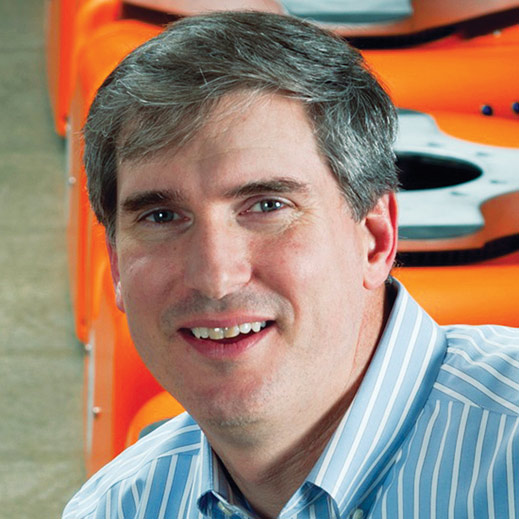The advent of the Web brought easier and faster ways of discovering, evaluating, and ordering almost every sort of product. But as Mick Mountz worked on distribution strategies for the online grocer Webvan in 2000, he confronted a basic problem: the limitations of systems that handle warehoused materials.

“They weren’t designed for picking orders—they were designed to bring pallets in and send cases out for retail distribution,” he recalls.
High fulfillment costs were a major factor in Webvan’s 2001 bankruptcy, which sent Mountz, who had previously worked at Motorola and as an Apple product manager, back to consumer electronics. But he kept thinking about the order fulfillment challenge.
“I’d always liked robots—I did my Course II undergraduate thesis on a robotic work holder for a machine tool,” he says. “I started seeing mobile robotics emerging and figured that if shelves full of products could walk and talk on their own, it would be an interesting way of organizing a warehouse.”
The idea led him to cofound Kiva Systems in 2003. The company has developed a system for material handling and e-commerce fulfillment that uses low-slung robots to lift and transport shelving pods to packing stations. Workers can pick two to four times as many orders per hour, and the warehouse becomes adaptive and self-organizing, with often-used pods staying closer to the packing area.
The complex system, which combines hardware and software, was a tough sell to investors and customers, but Mountz says his Apple experience gave him confidence. “We created everything from floor navigation stickers to the touch-screen interface, which helped us make it all just work for the customer,” he says.
After Staples became a customer in 2005, major companies like Walgreens, Zappos, the Gap, and Saks followed. Amazon acquired Kiva for $775 million in 2012, but Mountz remains its CEO.
Mountz credits the Institute with preparing him to “think in unstructured ways about hard problems.” He says, “It’s not formulaic—you’re required to think more broadly—and that’s definitely benefited me.”
But he adds, “The most important thing I got from MIT was a really smart, talented, and close group of lifelong friends.” Of 11 guys in his pledge class at Sigma Alpha Epsilon, he says, “six were involved in Kiva, including Pete Wurman ‘87, cofounder and CTO.”
Mountz and his wife, Tiffany, live in Lexington, Massachusetts, and this summer welcomed the arrival of their fourth little bot.
Keep Reading
Most Popular
Large language models can do jaw-dropping things. But nobody knows exactly why.
And that's a problem. Figuring it out is one of the biggest scientific puzzles of our time and a crucial step towards controlling more powerful future models.
How scientists traced a mysterious covid case back to six toilets
When wastewater surveillance turns into a hunt for a single infected individual, the ethics get tricky.
The problem with plug-in hybrids? Their drivers.
Plug-in hybrids are often sold as a transition to EVs, but new data from Europe shows we’re still underestimating the emissions they produce.
Google DeepMind’s new generative model makes Super Mario–like games from scratch
Genie learns how to control games by watching hours and hours of video. It could help train next-gen robots too.
Stay connected
Get the latest updates from
MIT Technology Review
Discover special offers, top stories, upcoming events, and more.